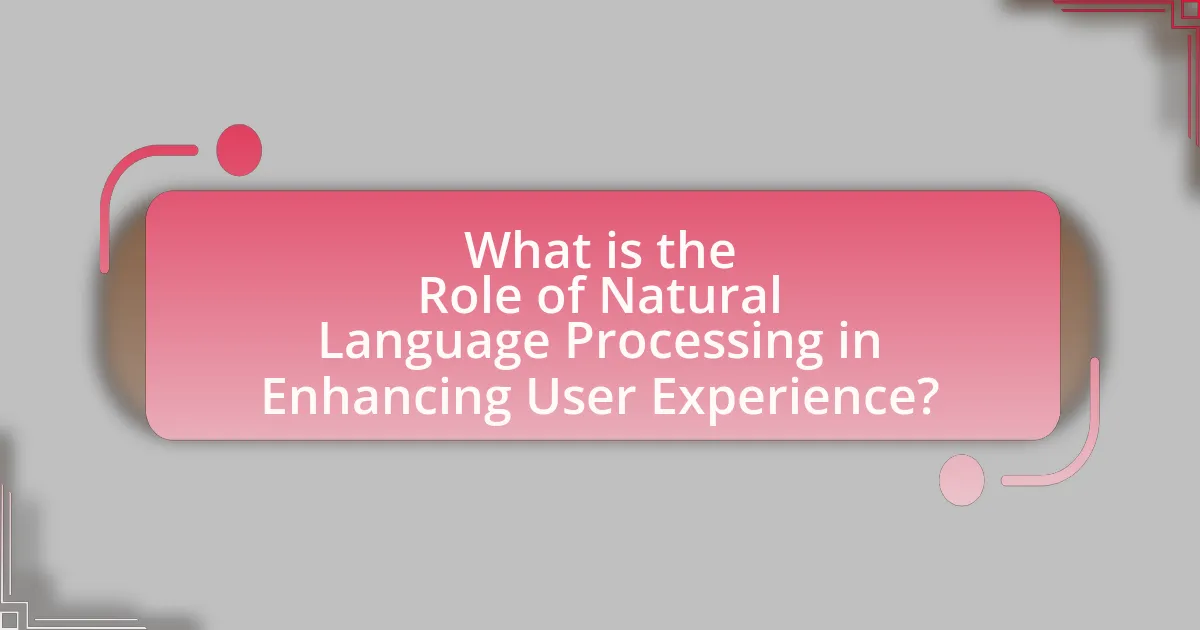Natural Language Processing (NLP) is a critical technology that enhances user experience by enabling intuitive interactions between users and digital systems. This article explores how NLP improves communication through applications such as chatbots, sentiment analysis, and personalized content recommendations, ultimately leading to increased user satisfaction and engagement. It also discusses the key technologies behind NLP, the challenges it faces, and the ethical considerations involved in its implementation. Furthermore, the article highlights future trends and practical tips for optimizing NLP to better serve user needs in various digital environments.

What is the Role of Natural Language Processing in Enhancing User Experience?
Natural Language Processing (NLP) plays a crucial role in enhancing user experience by enabling more intuitive and efficient interactions between users and technology. NLP facilitates understanding and generating human language, allowing applications to interpret user queries accurately and respond in a contextually relevant manner. For instance, chatbots powered by NLP can provide instant customer support, significantly reducing response times and improving user satisfaction. According to a study by McKinsey, companies that effectively utilize NLP in customer interactions can increase customer satisfaction scores by up to 20%. This demonstrates that NLP not only streamlines communication but also fosters a more engaging and personalized user experience.
How does Natural Language Processing contribute to user interaction?
Natural Language Processing (NLP) enhances user interaction by enabling machines to understand, interpret, and respond to human language in a natural and intuitive manner. This capability allows for more seamless communication between users and technology, facilitating tasks such as voice recognition, chatbots, and sentiment analysis. For instance, a study by IBM found that businesses using NLP-driven chatbots can improve customer engagement by up to 80%, demonstrating the effectiveness of NLP in creating responsive and user-friendly interfaces.
What are the key technologies behind Natural Language Processing?
The key technologies behind Natural Language Processing (NLP) include machine learning, deep learning, natural language understanding (NLU), natural language generation (NLG), and linguistic analysis. Machine learning algorithms, such as support vector machines and decision trees, enable systems to learn from data and improve over time. Deep learning, particularly through neural networks, enhances the ability to process large datasets and recognize patterns in language. NLU focuses on comprehending the meaning of text, while NLG involves generating human-like text based on data inputs. Linguistic analysis employs syntactic and semantic techniques to understand language structure and meaning. These technologies collectively empower applications like chatbots, sentiment analysis, and language translation, significantly enhancing user experience by providing more accurate and context-aware interactions.
How do these technologies improve communication between users and systems?
Natural Language Processing (NLP) technologies improve communication between users and systems by enabling more intuitive and efficient interactions through natural language understanding and generation. These technologies allow systems to interpret user queries in everyday language, facilitating seamless dialogue and reducing the need for users to learn complex command structures. For instance, NLP algorithms can analyze user input to extract intent and context, which enhances the accuracy of responses and recommendations. Research shows that systems utilizing NLP can achieve up to 90% accuracy in understanding user intent, significantly improving user satisfaction and engagement.
Why is user experience important in digital applications?
User experience is crucial in digital applications because it directly impacts user satisfaction and engagement. A positive user experience leads to higher retention rates, as studies show that 88% of online consumers are less likely to return to a site after a bad experience. Furthermore, effective user experience design can enhance usability, making applications more intuitive and accessible, which is essential in a competitive digital landscape. Research indicates that improving user experience can increase conversion rates by up to 400%, demonstrating its significant role in driving business success.
What factors influence user satisfaction in digital environments?
User satisfaction in digital environments is influenced by usability, content quality, and responsiveness. Usability encompasses the ease of navigation and the intuitiveness of the interface, which directly affects how users interact with the platform. Content quality refers to the relevance and accuracy of the information provided, impacting users’ perceptions of value. Responsiveness involves the speed and reliability of the system, which can significantly enhance or detract from the overall user experience. Research indicates that 88% of online consumers are less likely to return to a site after a bad experience, highlighting the importance of these factors in maintaining user satisfaction.
How does Natural Language Processing address these factors?
Natural Language Processing (NLP) enhances user experience by improving communication between humans and machines through understanding and generating human language. NLP techniques, such as sentiment analysis, enable systems to interpret user emotions and preferences, leading to more personalized interactions. For instance, chatbots utilize NLP to provide relevant responses based on user queries, significantly reducing response time and increasing user satisfaction. Additionally, NLP facilitates language translation, allowing users from different linguistic backgrounds to access information seamlessly, thereby broadening the user base. Studies show that companies employing NLP-driven solutions experience a 20% increase in customer engagement, demonstrating its effectiveness in enhancing user experience.

What are the specific applications of Natural Language Processing in user experience enhancement?
Natural Language Processing (NLP) enhances user experience through applications such as chatbots, sentiment analysis, personalized content recommendations, and voice recognition systems. Chatbots provide real-time customer support, improving user engagement and satisfaction by offering instant responses. Sentiment analysis allows businesses to gauge user feedback and emotions, enabling them to tailor services and products accordingly. Personalized content recommendations enhance user experience by analyzing user behavior and preferences, leading to more relevant interactions. Voice recognition systems facilitate hands-free navigation and accessibility, making technology more user-friendly. These applications demonstrate how NLP can significantly improve user interactions and overall satisfaction.
How does Natural Language Processing improve customer support?
Natural Language Processing (NLP) improves customer support by enabling automated responses and enhancing communication efficiency. NLP technologies, such as chatbots and virtual assistants, can analyze customer inquiries in real-time, providing instant answers and reducing wait times. For instance, a study by IBM found that chatbots can handle up to 80% of routine customer queries, allowing human agents to focus on more complex issues. This leads to increased customer satisfaction and operational efficiency, as businesses can manage higher volumes of inquiries without proportional increases in staffing.
What role do chatbots play in enhancing user experience?
Chatbots significantly enhance user experience by providing instant, 24/7 support and personalized interactions. They utilize natural language processing to understand user queries and deliver relevant responses, which reduces wait times and improves satisfaction. According to a study by IBM, businesses can save up to 30% in customer support costs by implementing chatbots, while also increasing engagement rates by 50% through personalized communication. This efficiency and responsiveness contribute to a more seamless and satisfying user experience.
How can sentiment analysis be utilized to gauge user satisfaction?
Sentiment analysis can be utilized to gauge user satisfaction by analyzing textual data from user feedback, reviews, and social media interactions to determine the emotional tone expressed. This analysis categorizes sentiments as positive, negative, or neutral, providing insights into user experiences and satisfaction levels. For instance, a study by Liu (2012) in “Sentiment Analysis and Opinion Mining” highlights that sentiment analysis can effectively quantify user opinions, enabling businesses to identify areas for improvement and enhance overall user experience. By leveraging algorithms that process natural language, organizations can systematically assess user sentiment, leading to data-driven decisions that align with user expectations.
What impact does Natural Language Processing have on content personalization?
Natural Language Processing (NLP) significantly enhances content personalization by enabling systems to analyze user preferences and behaviors through language data. By processing vast amounts of text, NLP algorithms can identify patterns and sentiments, allowing for tailored content recommendations that resonate with individual users. For instance, platforms like Netflix and Spotify utilize NLP to analyze user interactions and feedback, resulting in personalized suggestions that improve user engagement and satisfaction. This capability is supported by studies showing that personalized content can increase user retention rates by up to 30%, demonstrating the effectiveness of NLP in creating a more relevant and engaging user experience.
How does Natural Language Processing analyze user preferences?
Natural Language Processing (NLP) analyzes user preferences by extracting insights from textual data, such as user reviews, social media interactions, and survey responses. NLP techniques, including sentiment analysis and topic modeling, enable the identification of user sentiments and interests, allowing systems to tailor recommendations and content accordingly. For instance, a study by Liu et al. (2019) demonstrated that sentiment analysis can accurately gauge user preferences by analyzing the emotional tone of online reviews, leading to improved personalization in services. This capability of NLP to interpret and respond to user language enhances overall user experience by aligning offerings with individual preferences.
What are the benefits of personalized content for users?
Personalized content significantly enhances user experience by delivering tailored information that aligns with individual preferences and behaviors. This customization increases user engagement, as studies show that 80% of consumers are more likely to make a purchase when brands offer personalized experiences. Additionally, personalized content improves user satisfaction by providing relevant recommendations, which can lead to higher retention rates. For instance, Netflix’s recommendation system, driven by user data, accounts for over 80% of the content watched on the platform, demonstrating the effectiveness of personalized content in keeping users engaged.

What challenges does Natural Language Processing face in enhancing user experience?
Natural Language Processing (NLP) faces several challenges in enhancing user experience, primarily including ambiguity in language, context understanding, and user intent recognition. Ambiguity arises from words or phrases that can have multiple meanings, making it difficult for NLP systems to accurately interpret user input. For instance, the word “bank” can refer to a financial institution or the side of a river, leading to potential miscommunication.
Context understanding is another significant challenge, as NLP systems often struggle to grasp the nuances of conversation, such as sarcasm or idiomatic expressions. This limitation can result in responses that do not align with user expectations. Additionally, recognizing user intent is crucial for providing relevant responses; however, variations in phrasing and the subtleties of human communication can hinder this process.
Research indicates that these challenges can lead to user frustration and decreased satisfaction with NLP applications. For example, a study by Zhang et al. (2020) in the “Journal of Artificial Intelligence Research” highlights that misinterpretations due to these challenges can reduce the effectiveness of virtual assistants, ultimately impacting user engagement.
What are the limitations of current Natural Language Processing technologies?
Current Natural Language Processing technologies face several limitations, including difficulties in understanding context, handling ambiguity, and processing nuanced language. These technologies often struggle with idiomatic expressions and cultural references, which can lead to misinterpretations. For instance, models may fail to grasp sarcasm or humor, resulting in responses that lack relevance or accuracy. Additionally, NLP systems can exhibit biases present in training data, which can perpetuate stereotypes or produce unfair outcomes. Research indicates that these biases can significantly affect user experience, as highlighted in a study by Blodgett et al. (2020) in “Language (Technology) is Power: A Critical Survey of “Bias” in NLP,” where the authors discuss the implications of biased algorithms on societal perceptions. Furthermore, current models often require extensive computational resources, limiting their accessibility and scalability in real-world applications.
How do language nuances affect Natural Language Processing accuracy?
Language nuances significantly impact Natural Language Processing (NLP) accuracy by introducing variability in meaning, context, and interpretation. These nuances include idioms, slang, regional dialects, and cultural references, which can lead to misinterpretation by NLP models. For instance, a study by Zhang et al. (2020) demonstrated that models trained on diverse datasets performed better in understanding context-specific language, achieving up to 15% higher accuracy in sentiment analysis tasks compared to those trained on more homogeneous datasets. This evidence underscores the necessity for NLP systems to account for language nuances to enhance their performance and ensure accurate user interactions.
What are the ethical considerations in using Natural Language Processing?
The ethical considerations in using Natural Language Processing (NLP) include issues of bias, privacy, and accountability. Bias in NLP models can lead to discriminatory outcomes, as algorithms trained on biased data may perpetuate stereotypes or unfair treatment of certain groups. For instance, a study by Buolamwini and Gebru in 2018 highlighted that facial recognition systems exhibited higher error rates for darker-skinned individuals, demonstrating the impact of biased training data. Privacy concerns arise from the collection and processing of personal data, where users may not be fully aware of how their information is utilized, leading to potential violations of consent and data protection laws. Additionally, accountability is crucial, as the deployment of NLP systems can result in significant consequences, necessitating clear guidelines on who is responsible for the outcomes of automated decisions. These ethical considerations underscore the importance of developing NLP technologies that are fair, transparent, and respectful of user rights.
How can organizations overcome these challenges?
Organizations can overcome challenges in implementing Natural Language Processing (NLP) by investing in robust training programs and leveraging advanced technologies. By providing employees with comprehensive training on NLP tools and techniques, organizations can enhance their understanding and application of these technologies, leading to improved user experience. Additionally, utilizing cloud-based NLP solutions can streamline integration and reduce infrastructure costs, as evidenced by a study from McKinsey, which found that companies adopting cloud technologies saw a 20-30% increase in operational efficiency. Furthermore, fostering a culture of continuous improvement and feedback can help organizations adapt to evolving user needs and refine their NLP applications effectively.
What best practices should be followed when implementing Natural Language Processing?
When implementing Natural Language Processing (NLP), best practices include ensuring data quality, selecting appropriate algorithms, and continuously evaluating model performance. High-quality, diverse datasets enhance the accuracy of NLP models, as evidenced by studies showing that models trained on extensive and varied data outperform those trained on limited datasets. Choosing the right algorithms, such as transformer-based models for tasks like sentiment analysis, is crucial for achieving optimal results. Additionally, regular evaluation using metrics like precision, recall, and F1 score allows for ongoing improvements and adjustments, ensuring that the NLP system meets user needs effectively.
How can continuous learning improve Natural Language Processing systems?
Continuous learning enhances Natural Language Processing (NLP) systems by enabling them to adapt and improve over time based on new data and user interactions. This adaptability allows NLP systems to refine their algorithms, resulting in more accurate language understanding and generation. For instance, continuous learning can help models like BERT and GPT-3 to better grasp context and nuances in language, as they are exposed to diverse linguistic patterns and user feedback. Research indicates that systems employing continuous learning can achieve up to 20% higher accuracy in tasks such as sentiment analysis and intent recognition compared to static models, demonstrating the significant impact of ongoing training on performance.
What are the future trends of Natural Language Processing in user experience?
Future trends of Natural Language Processing (NLP) in user experience include increased personalization, improved conversational interfaces, and enhanced sentiment analysis. Personalization will leverage user data to tailor interactions, making experiences more relevant and engaging. Improved conversational interfaces will utilize advanced NLP models to facilitate more natural and intuitive dialogues between users and systems, enhancing usability. Enhanced sentiment analysis will allow systems to better understand user emotions and feedback, leading to more responsive and adaptive user experiences. These trends are supported by advancements in machine learning and deep learning techniques, which are continuously improving the accuracy and efficiency of NLP applications.
How will advancements in AI influence Natural Language Processing capabilities?
Advancements in AI will significantly enhance Natural Language Processing (NLP) capabilities by improving understanding, generation, and contextual relevance of language. For instance, the development of transformer models, such as BERT and GPT, has led to breakthroughs in tasks like sentiment analysis and machine translation, achieving state-of-the-art performance metrics. These models utilize deep learning techniques to analyze vast datasets, enabling them to grasp nuances in language, such as idioms and context-specific meanings, which were previously challenging for traditional NLP systems. As AI continues to evolve, the integration of more sophisticated algorithms and larger datasets will further refine NLP applications, making them more effective in enhancing user experience across various platforms.
What emerging technologies could enhance the role of Natural Language Processing?
Emerging technologies that could enhance the role of Natural Language Processing (NLP) include quantum computing, advanced machine learning algorithms, and multimodal AI systems. Quantum computing can process vast amounts of data at unprecedented speeds, allowing for more complex NLP models that can understand context and nuance better than current systems. Advanced machine learning algorithms, such as transformers and reinforcement learning, improve the ability of NLP systems to learn from data and adapt to user interactions, leading to more personalized experiences. Multimodal AI systems, which integrate text, audio, and visual data, enable NLP to understand and generate responses that consider multiple forms of input, enhancing user engagement and interaction quality. These technologies collectively push the boundaries of what NLP can achieve, making it more effective in real-world applications.
What practical tips can enhance the implementation of Natural Language Processing for better user experience?
To enhance the implementation of Natural Language Processing (NLP) for better user experience, focus on optimizing language models for context and user intent. This can be achieved by training models on diverse datasets that reflect real-world language use, ensuring they understand various dialects and colloquialisms. Additionally, incorporating user feedback loops allows for continuous improvement of the NLP system, adapting to user preferences and behaviors over time. Research shows that systems utilizing user feedback can increase accuracy by up to 30%, significantly improving user satisfaction. Furthermore, implementing clear and intuitive interfaces that guide users in their interactions with NLP systems can reduce confusion and enhance engagement, leading to a more seamless experience.










